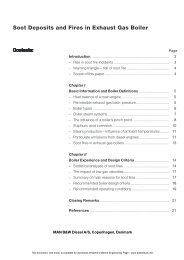Fire on Board the Liberian Passenger Ship Ecstasy, Miami, Florida ...
Fire on Board the Liberian Passenger Ship Ecstasy, Miami, Florida ...
Fire on Board the Liberian Passenger Ship Ecstasy, Miami, Florida ...
- No tags were found...
You also want an ePaper? Increase the reach of your titles
YUMPU automatically turns print PDFs into web optimized ePapers that Google loves.
Analysis 58 Marine Accident Reportraised positi<strong>on</strong>, which left a gap between <strong>the</strong> rollers and <strong>the</strong> entry housing to <strong>the</strong> adjacentexhaust ducts. This gap allowed <strong>the</strong> fire to spread into <strong>the</strong> roller exhaust ducts, which wasevidenced by heat damage to <strong>the</strong> paint <strong>on</strong> <strong>the</strong> exhaust ducts. In additi<strong>on</strong>, <strong>the</strong> roller exhaustducts c<strong>on</strong>tained several inches of burned debris.Postaccident examinati<strong>on</strong> of <strong>the</strong> mangle blowers revealed that <strong>the</strong>y were cakedwith partially burned lint and wax. The impeller <strong>on</strong> <strong>the</strong> aft fan had disintegrated, leavingrust-colored metal flakes imbedded in <strong>the</strong> lint and wax. The absence of an operati<strong>on</strong>al fanin this duct allowed more lint to accumulate in it than in <strong>the</strong> forward duct, which resultedin <strong>the</strong> aft duct sustaining far greater heat damage.In additi<strong>on</strong> to <strong>the</strong> damage in <strong>the</strong> mangle’s vertical exhaust ducts, investigatorsfound 2-3 inches of burned debris in <strong>the</strong> main ventilati<strong>on</strong> duct above <strong>the</strong> machine. <str<strong>on</strong>g>Fire</str<strong>on</strong>g>damage was present throughout <strong>the</strong> mangle exhaust duct system of <strong>the</strong> <strong>Ecstasy</strong>, indicating<strong>the</strong> fire probably proceeded through this system into <strong>the</strong> air c<strong>on</strong>diti<strong>on</strong>ing room where itspread through <strong>the</strong> plenum exhaust ducts <strong>on</strong>to <strong>the</strong> mooring deck. The fire <strong>the</strong>n ignited lintthat had been exhausted to <strong>the</strong> mooring deck and that had become imbedded in <strong>the</strong>mooring line. The burning lint, in turn, ignited <strong>the</strong> mooring lines, which fueled a large,intense fire that raged for more than 2 hours, damaging deck areas above, forward, andbelow <strong>the</strong> mooring deck. Hot gases and smoke transferred from <strong>the</strong> mooring deck to o<strong>the</strong>rareas of <strong>the</strong> vessel through <strong>the</strong> air c<strong>on</strong>diti<strong>on</strong>ing ventilati<strong>on</strong> system before bridge pers<strong>on</strong>nelsecured <strong>the</strong> system. The ventilati<strong>on</strong> supply intakes for <strong>the</strong> stern thruster room, which arenext to <strong>the</strong> laundry room’s exhaust plenum <strong>on</strong> <strong>the</strong> mooring deck, transferred smoke andheat from <strong>the</strong> fully developed fire through <strong>the</strong> vent ducts into <strong>the</strong> stern thruster room,causing extensive damage <strong>the</strong>re. Hot gases and smoke traveling through <strong>the</strong> ventilati<strong>on</strong>ducts also caused extensive heat damage and sooting in <strong>the</strong> steering gear rooms, severalpassenger cabins <strong>on</strong> decks Nos. 4, 5, 6 and 7, and <strong>the</strong> laundry crew galley. The injecti<strong>on</strong> ofsmoke and fire gases from <strong>the</strong> mooring deck fire into <strong>the</strong> intake systems caused <strong>the</strong> almostsimultaneous activati<strong>on</strong> of smoke detectors <strong>on</strong> four different decks.Based <strong>on</strong> <strong>the</strong> amount of burned lint debris <strong>on</strong> <strong>the</strong> <strong>Ecstasy</strong>, investigators examined<strong>the</strong> main laundries of o<strong>the</strong>r Fantasy vessels and found large lint accumulati<strong>on</strong>s in <strong>the</strong>irlaundry exhaust systems, particularly <strong>the</strong> mangle exhaust ducts next to and above <strong>the</strong>machine. On <strong>on</strong>e such ship, <strong>the</strong> Fantasy, <strong>the</strong> chief engineer stated that he had initiated aprogram of cleaning <strong>the</strong> exhaust ducts and plenum about every 20 days after he hadexperienced a problem closing a damper and had found <strong>the</strong> ducts clogged with lint.Although crew pers<strong>on</strong>nel had cleaned <strong>the</strong> ducts 4-5 days before <strong>the</strong> Safety <strong>Board</strong>’sinspecti<strong>on</strong>, investigators found several inches of lint buildup in <strong>the</strong> dryer ducts and <strong>the</strong>plenum. They also found that <strong>the</strong> mangle duct c<strong>on</strong>tained about ½ of an inch of lint and wascoated with a waxy/oily substance. On <strong>the</strong> mooring deck, investigators found that lintexhausted through <strong>the</strong> ventilati<strong>on</strong> system had settled <strong>on</strong> and become imbedded in <strong>the</strong>mooring lines.Flammability tests of lint collected from <strong>the</strong> sister ships showed that <strong>the</strong> materialwas ignited easily by a spark and burned for several sec<strong>on</strong>ds, leaving little residualmaterial behind. Therefore, <strong>the</strong> large lint buildup in <strong>the</strong> exhaust vents and <strong>the</strong> ventilati<strong>on</strong>system represented such a hazard that a fire might have occurred even if <strong>the</strong> fitters had
















